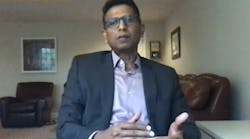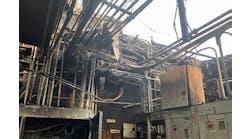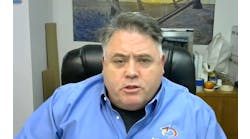Transformational successes in face of COVID challenges
“To make solutions that matter, Advanced Manufacturing Center of Excellence members engage with factory folks for ideas from the floor. We upskill and reskill to make manufacturing a career, with a dedicated human resources and training team.” Stanley Black & Decker’s Sudhi Bangalore explained how the company’s Digital Continuous Improvement Program, or DCIP, facilitates advances that scale across the enterprise.
Stanley Black & Decker is the number one tool company around the globe, with 13,000 patents, 61,000 employees and nine major distribution centers. The company has 145 factories, a mixture of legacy, mid-mature and flagship plants.
“PwC has named us its number three top innovator,” said Sudhi Bangalore, CTO, Global Operations, Stanley Black & Decker. Bangalore presented “Stanley Black & Decker: The future of manufacturing,” one of several stories about what companies are doing to succeed despite the pandemic, during the Wednesday Perspectives keynote session this week at Automation Fair at Home.
“Our digitalization program is enterprise-driven, with support from the board and president down. It gets the right attention and funding, and has enterprise-wide goals as well as a system to deliver on them,” Bangalore said. “We have a mix of large and small partners including Rockwell Automation, Microsoft, Fanuc and Cisco as well as FogHorn Systems and Genesys.”
Stanley Black & Decker opened a new Advanced Manufacturing Center of Excellence in 2019 in Hartford, Connecticut, to establish practices and help partners work with us. The location in Hartford also helps local innovation in Connecticut and contributes to the re-industrialization of the area, “the larger good,” said Bangalore.
“The Connected Enterprise is a foundational solution,” Bangalore said. It helps them seek out the dull, dirty, dangerous tasks and replace them with technology.
The delivery structure includes people with experience in many industries—pharmaceuticals, automotive, etc.—for cross-pollination. “To make solutions that matter, Center of Excellence members engage with factory folks for ideas from the floor,” said Bangalore. The system uses technology and process with people at the center. “We upskill and reskill to make manufacturing a career, with a dedicated human resources and training team.”
People come and go, but the company’s digital continuous improvement program (DCIP) makes the process real-time and continuous. Algorithms hunt and recognize opportunities, and it allows factory workers to interact with off-site resources, immediately run and see the results of alternatives, and to trap, aggregate and serve improvements up to the organization for global implementation.
It works with existing continuous improvement structures, adding artificial intelligence, collaboration and automation, so insights become actions in minutes instead of weeks.
“We all have our own transformations to undergo, small or major,” Bangalore said. “I hope this helps you on your journey.”
Georgia-Pacific takes on skill shortage
“Technology drives our plant productivity, but it takes people to make technology run,” said Mike Carroll, senior vice president, innovation & transformation, Georgia-Pacific. With the Boomer generation retiring, the company’s electrical and instrument (E&I) positions are not being filled. “Last year at Automation Fair, Accenture and Rockwell Automation announced a partnership, and I suggested we work on this problem together for us and for others in industry,” Carroll said.
“Rockwell Automation brings depth of technology, Accenture has integration and Georgia-Pacific has production knowledge, assets and data,” added Pete Frandina, managing director, North America Industry, Accenture. How can they become less reliant on filling positions? How can they give the technicians the information and insights they need to be more productive?
“It’s early on, but please think about the applicability to your organization—where you have stranded information, a need and open requisitions, where you need to get more from your people,” said Frandina. “We’re seeing how this will help Georgia-Pacific, and it might help you.”
Southwire seeks actionable information
Southwire International has collected a lot of data over the years, but has outdated tools to put that data to work. The company has called on Rockwell Automation and Oden Technologies to help. “We’re both working on bringing The Connected Enterprise to life—Rockwell Automation brings technology, we add intelligence that tells you to look here, look now,” said Willem Sundblad, chief executive officer, Oden Technologies. Oden is one of the newest members of the Rockwell Automation partnership system.
“It’s a long journey, not overnight,” said Will Berry, senior vice president, Southwire. “We’re focusing on a strong, scalable foundation and improving the daily experience of employees by removing redundant and non-value-added tasks. We’re engaging our lean process, quality and manufacturing leaders to align them, and working with employees to learn what makes their life frustrating, from writing on paper to learning the next steps in a process.”
Sundblad said, “We’re fitting into their workflow to make the next steps faster, both in infrastructure and culture, to see what part of OEE (overall equipment effectiveness) will move the needle fastest. We need data, but also to analyze and fit the results into the lives of the workers.”
Berry described what’s important in a partner. “First, help us stay on course, to avoid scope creep,” he said. “Second, enhance and expand your products to fit our needs. Third, provide a robust and reliable architecture. Cybersecurity, for example, is important to protect IT and OT.”
The editors of Control, Control Design and Smart Industry are providing coverage of Automation Fair At Home, bringing you breaking news, innovations and insights from the virtual event. Once Automation Fair At Home is over, the editors will put together an event report featuring the top news. Pre-order your copy today.






